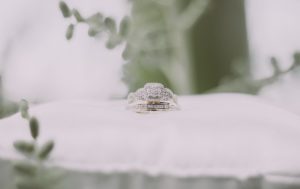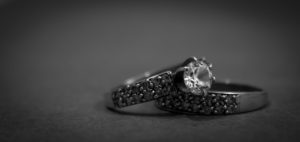Flawless and Internally Flawless Diamonds
 Flawless diamonds have no inclusions or characteristics and are extremely rare. The inclusions and blemishes present on flawless diamonds cannot be seen with even 10X magnification by even the most skilled graders.
Flawless diamonds have no inclusions or characteristics and are extremely rare. The inclusions and blemishes present on flawless diamonds cannot be seen with even 10X magnification by even the most skilled graders.
These diamonds also tend to be far smaller in size and of all the diamonds found in the world, less than 0.1% fall under the flawless category. Flawless diamonds, therefore, tend to be incredibly expensive. Internally flawless diamonds, on the other hand, have no inclusions but can have minute blemishes, detectable in 10x magnification. Most of the blemishes are polish lines left behind during polishing. The good thing is that these blemishes do not affect the sparkle of the diamond and thus, internally flawless diamonds are also highly coveted and incredibly expensive.
Very, Very Slightly Included (VVS) Diamonds
Very, Very Slightly Included (VVSI) diamonds are further sub-categorized into Very, Very Slightly Included 1 (VVS1) diamonds and Very, Very Slightly Included 2 (VVS2) diamonds.
Very, Very Slightly Included 1 (VVS1) Diamonds
Very, Very Slight Included 1 or VVS1 diamonds have very minute, either pin-point or natural inclusions that are not detectable even under 10x magnification. A skilled grader may be able to see these inclusions, especially if they exist near the pavilion. However, the inclusions are not visible to the naked eye. VVS1 diamonds have almost the same appeal and sparkle as Flawless or Internally Flawless diamonds. However, since these diamonds have minute inclusions, they are more affordable than Flawless and Internally Flawless diamonds and offer better value for money.
Very, Very Slightly Included 2 (VVS2) Diamonds
Very, Very Slightly Included 2 or VVS2 diamonds have minute inclusions that are visible under magnification. However, these inclusions do not compromise the quality or the sparkle of the diamond and thus, VVS2 diamonds are considered to be high-grade, high-quality diamonds. The most common types of inclusions found on VVS2 diamonds include cloud, feather, natural, and pinpoint inclusions.
Very Slightly Included (VS) Diamonds
This broader category is further divided into two sub-categories: Very Slightly Included 1 (VS1) and Very Slightly Included 2 (VS2).
Very Slightly Included 1 (VS1) Diamonds
Very Slightly Included or VS1 diamonds have small inclusions that are not visible to the naked eye but can impact the brilliance of a diamond. Cloud, crystal, feather, indented natural, and needle are the common types of inclusions found in VS1 diamonds. VS1 diamonds are quite popular among jewelry lovers.
Very Slightly Included 2 (VS2) Diamonds
Very Slightly Included 2 or VS2 diamonds have inclusions that are only slightly bigger than the inclusions present on VS1 diamonds. The common types of inclusions found in these diamonds include cloud, crystal, feather, indented natural, and twinning wisp inclusions. Though these inclusions are slightly bigger, they are still not visible to the naked eye — only a skilled grader can separate a VS2 from a VS1 diamond. VS2 diamonds are more affordable and thus, buyers going with this variety can choose a higher carat or better cut for the same price.
Slightly Included (SI) Diamonds
Slightly Included diamonds are further categorized into two categories: Slightly Included 1 (SI1) and Slightly Included 2 (SI2).
Slightly Included 1 (SI1)
Slightly Included diamonds have inclusions that are visible to the naked eye. However, in the case of Slightly Included 1 or SI1 diamonds, the inclusions are mostly small and not visible to the unaided eye. SI1 diamonds with inclusions located off-center are considered a better choice than diamonds with inclusions close to the center. Slightly Included diamonds are not easy to find. However, their affordable price and good brilliance make them a popular choice.
Slightly Included 2 (SI2)
SI2 diamonds possess good brilliance. However, the inclusions located on these diamonds may have inclusions visible to the naked eye. If you are planning to buy an SI2 grade diamond, it’s a better idea to choose a diamond with many small inclusions over a diamond with a big inclusion. Similarly, buyers must also refrain from investing their money in an SI2 diamond with a large and central cloud or crystal inclusions as these types of inclusions are easily noticeable to the naked eye. Inclusions found in SI2 diamonds are mostly black.
Included Diamonds
Included diamonds are further categorized into I1, I2, and I3 categories. Though the I1 category has inclusions visible to the naked eye, these inclusions do not significantly affect the brilliance of the diamond. Thus, those shopping on constricted budgets or looking for budget-friendly choices can opt for these diamonds. Common I1 inclusions include clouds, crystals, feathers, and knots. Steer clear of any I1 diamond with a single large inclusion. I2 and I3 diamonds, on the other hand, have inclusions large enough to meddle with the brilliance and sparkle of the diamond. Thus, jewelers often advise against investing in I2 and I3 diamonds.
Here Are a Few Tips on How to Get Best Value for Money While Buying Diamonds
Of all the four Cs, diamond clarity is perhaps the most important factor to consider while buying a diamond. However, many people presume that a high-clarity grade that burns holes in pockets will sparkle the best and thus, is the best choice. This is a misconception. The truth is VS and SI grades are considered to be the best choices while buying diamonds as the inclusions in these diamonds are not noticeable to the naked eye and do not affect the brilliance of the diamond. At the same time, their affordable pricing allows buyers to also focus on the other Cs, i.e. cut, color, and carat. Further, buyers must also know that a diamond’s cut and color also affect its clarity. Thus, if you are planning to buy a big diamond in a fancy shape, such as the Asscher or Emerald cut, it is a better idea to invest in a higher quality grade diamond.
We hope this guide has been successful in clearly explaining the diamond clarity grade chart to its readers and will allow them to make the right choice while buying their next diamond.
 For centuries now, diamonds have remained the most coveted of all gemstones. The beauty of a diamond is often associated with its clarity.
For centuries now, diamonds have remained the most coveted of all gemstones. The beauty of a diamond is often associated with its clarity.